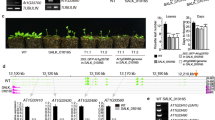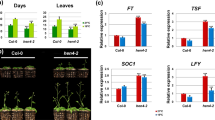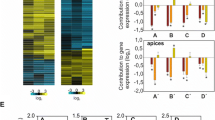Abstract
FLOWERING LOCUS M (FLM) is a MADS-domain gene that acts as an inhibitor of flowering in Arabidopsis. Here we describe the genetic interaction of FLM with genes in the photoperiod and autonomous flowering pathways. Although the sequence of FLM is most similar to that of FLC, FLM and FLC interact with different flowering pathways. It has been previously shown that flc lesions suppress the late-flowering phenotype of FRI-containing lines and autonomous-pathway mutants. However, flm lesions suppress the late-flowering phenotype of photoperiod-pathway mutants but not that of FRI-containing lines or autonomous-pathway mutants. Another MADS-domain flowering repressor with a mutant phenotype similar to FLM is SVP. The late-flowering phenotype of FLM over-expression is suppressed by the svp mutation, and an svp flm double mutant behaves like the single mutants. Thus FLM and SVP are in the same flowering pathway which interacts with the photoperiod pathway.
Abbreviations: CO, CONSTANS; FLC, FLOWERING LOCUS C; FLM, FLOWERING LOCUS M; FRI, FRIGIDA; GI, GIGANTEA; LD, LUMINIDEPENDENS; SVP, SHORT VEGETATIVE PHASE; FCA is not an abbreviation
Similar content being viewed by others
References
Alvarez-Buylla, E.R., Liljegren, S.J., Pelaz, S., Gold, S.J., Burgeff, C., Ditta, G.S., Vergara-Silva, F. and Yanofsky, M.F. 2000. MADS-box gene evolution beyound flowers: expression in pollen, endosperm, guard cell, roots and trichomes. Plant J. 24: 1–11.
Gendall, A.R., Levy, Y.Y., Wilson, A. and Dean, C. 2001. The VERNALIZATION2 gene mediates the epigenetic regulation of vernalization in Arabidopsis. Cell 107: 525–535.
Hartmann, U., Hohmann, S., Nettesheim, K., Wisman, E., Saedler, H. and Huijser, P. 2000. Molecular cloning of SVP: a negative regulator of the floral transition in Arabidopsis. Plant J. 21: 351–360.
Honma, T. and Goto, K. 2001. Complexes of MADS-box proteins are sufficient to convert leaves into floral organs. Nature 409: 525–529.
Immink, R.G.H., Gadella, T.W.J., Ferrario, S., Busscher, M. and Angenent, G.C. 2002. Analysis of MADS box protein-protein interactions in living plant cells. Proc. Natl. Acad. Sci. USA 99: 2416–2421.
Johanson, U., West, J., Lister, C., Michaels, S., Amasino, R. and Dean, C. 2000. Molecular analysis of FRIGIDA, a major determinant of natural variation in Arabidopsis flowering time. Science 290: 344–347.
Koornneef, M., Alonso-Blanco, C., Peeters, A.J. and Soppe, W. 1998a. Genetic control of flowering time in Arabidopsis. Annu. Rev. Plant Physiol. Plant Mol. Biol. 49: 345–370.
Koornneef, M., Alonso-Blanco, C., Blankestijin-de-Vries, H., Hanhart, C.J. and Peeters, A.J. 1998b. Genetic interactions among late-flowering mutants of Arabidopsis. Genetics 148: 885–892.
Lee, I., Michaels, S.D., Masshardt, A.S. and Amasino, R.M. 1994. The late-flowering phenotype of FRIGIDA and LUMINIDEPENDENS is suppressed in the Landsberg erecta strain of Arabidopsis. Plant J. 6: 903–909.
Meier, C., Bouquin, T., Nielsen, M.E., Raventos, D., Mattsson, O., Rocher, A., Schomburg, F., Amasino, R.M. and Mundy, J. 2001. Gibberellin response mutants identified by luciferase imaging. Plant J. 25: 509–519.
Michaels, S. and Amasino, R. 1999. FLOWERING LOCUS C encodes a novel MADS domain protein that acts as a repressor of flowering. Plant Cell 11: 949–956.
Michaels, S. and Amasino, R. 2000. Memories of winter: vernalization and the competence to flower. Plant Cell Environ 23: 1145–1154.
Michaels, S. and Amasino, R. 2001. Loss of FLOWERING LOCUS C activity eliminates the late-flowering phenotype of FRIGIDA and autonomous-pathway mutations, but not responsiveness to vernalization. Plant Cell 13: 935–941.
Park, D.H., Somer, D.E., Kim, Y.S., Choy, Y.H., Lim, H.K., Soh, M.S., Kim, H.J., Kay, S.A. and Nam, H.G. 1999. Control of circadian rhythms and photoperiod flowering by the Arabidopsis GIGANTEA gene. Science 285: 1579–1582.
Pelaz, S., Ditta, G.S., Baumann, E., Wisman, E. and Yanofsky, M.F. 2000. B and C floral organ identity functions require SEPALLATA MADS-box genes. Nature 405: 200–203.
Putterill, J., Robson, F., Lee, K., Simon, R. and Coupland, G. 1995. The CONSTANS gene of Arabidopsis promotes flowering and encodes a protein showing similarities to zinc finger transcription factors. Cell 80: 847–857.
Ratcliffe, O.J., Nadzan, G.C., Reuber, T.L. and Riechmann, J.L. 2001. Regulation of flowering in Arabidopsis by an FLC homologue. Plant Physiol. 126: 122–132.
Reeves, P.H. and Coupland, G. 2000. Response of plant development to environment: control by daylength and temperature. Curr. Opin. Plant Biol. 3: 37–42.
Riechmann, J.L. and Meyerowitz, E.M. 1997. MADS domain proteins in plant development. J. Biol. Chem. 378: 1079–1101.
Scortecci, K.C., Michaels, S.D. and Amasino, R.M. 2001. Identification of a MADS-box gene, FLOWERING LOCUS M, that represses flowering. Plant J. 26: 229–236.
Sheldon, C.C., Burn, J.E., Perez, P.P., Metzger, J., Edwards, J.A., Peacock, W.J. and Dennis, E.S. 1999. The FLF MADSbox gene. A repressor of flowering in Arabidopsis regulated by vernalization and methylation. Plant Cell 11: 445–458.
Sheldon, C.C., Coon, A.B., Dennis, E.S. and Peacock, W.J. 2002. Different regulations regions are required for the vernalizationinduced of FLOWERING LOCUS C and for the epigenetic maintenance of repression. Plant Cell 14: 2527–2537.
Simpson, C.G. and Dean, C. 2002. Arabidopsis, the rosette stone of flowering time? Science 296: 285–289.
Suarez-Lopez, P., Wheatly, K., Robson, F., Onouchi, H., Valverde, F. and Coupland, G. 2001. CONSTANS mediates between the circadian clock and the control of flowering in Arabidopsis. Nature 410: 1116–1120.
Author information
Authors and Affiliations
Corresponding author
Rights and permissions
About this article
Cite this article
Scortecci, K., Michaels, S.D. & Amasino, R.M. Genetic interactions between FLM and other flowering-time genes in Arabidopsis thaliana . Plant Mol Biol 52, 915–922 (2003). https://doi.org/10.1023/A:1025426920923
Issue Date:
DOI: https://doi.org/10.1023/A:1025426920923




